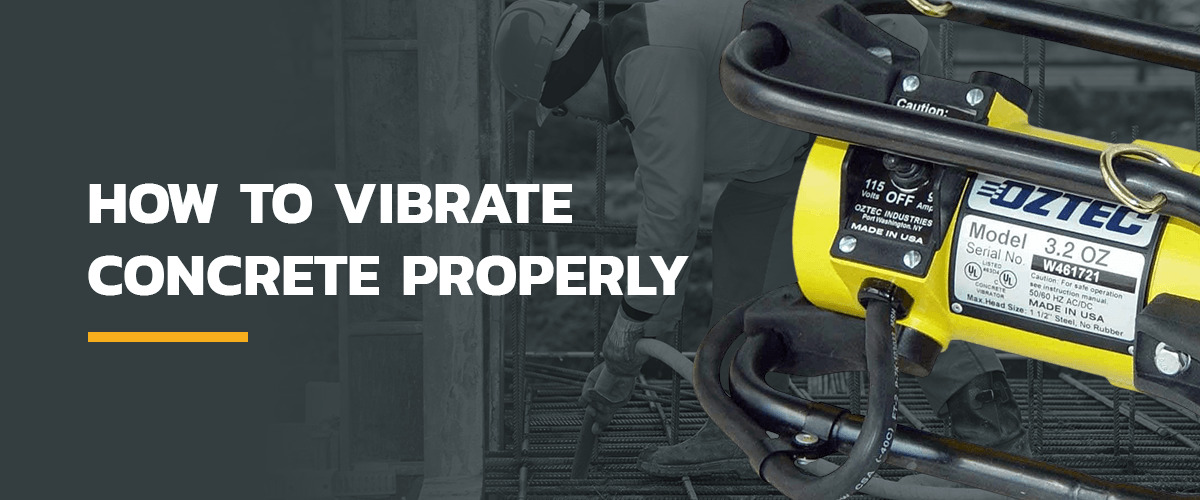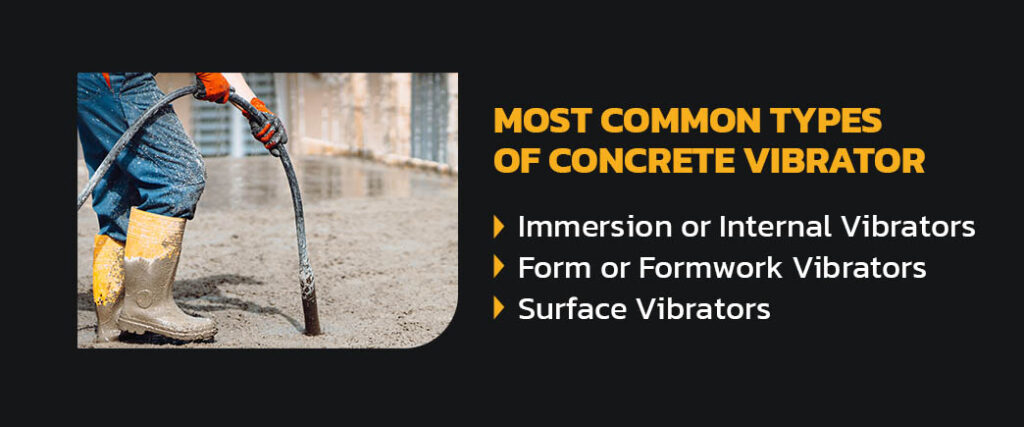How to Vibrate Concrete Properly
Posted On: 05/05/2024 | Posted by: DY Concrete Pumps

Is it necessary to vibrate concrete? Does vibrating concrete make it stronger? If you’re not sure when to use a concrete vibrator or how to vibrate concrete properly for your construction projects, here is all the information you need.
What Is Concrete Vibrating?
Whenever you pour concrete, tiny air bubbles form. Depending on the mix and the pour, there can be thousands of these air bubbles. The more air bubbles you have in your concrete, the weaker its structural integrity when it hardens. A concrete vibrator is a concrete tool that produces stronger concrete by vigorously shaking the concrete right after you pour it to eliminate the air bubbles or air pockets.
Why Use a Concrete Vibrator?
Concrete vibrators are great tools for getting the best concrete results. The vibration transforms your concrete into high-quality, durable material easily. If you work with concrete, here’s why you need a concrete vibrator:
- Improved strength: The better you compact your concrete, the denser it will be. Vibrating concrete gives it a higher compressive strength, which creates more durable concrete.
- Remove air: When you pour concrete, air bubbles can get trapped inside. Trapped air can lead to voids and cracking in your finished concrete, weakening the structure. Vibrators help eliminate air voids by evenly compacting the concrete.
- Minimize bleeding: Bleeding is when water moves upwards through the concrete and out the top. Vibrating helps stop bleeding by creating an even material distribution. It also prevents segregation — when the mortar and aggregates separate. Vibrating concrete gives you a more uniform mixture that has fewer problems.
- Enhanced workability: Vibrating also makes concrete more manageable. The vibrations help move the concrete around forms and reinforcement. You get better concrete distribution faster when you use vibrating equipment.
- Smoother finish: Since vibrating concrete mixes the aggregates better and compacts the concrete, you get a smoother finish. Smooth surfaces are essential for decorative or architectural elements. You’ll minimize surface imperfections and get a longer-lasting result.
- Better savings: Vibrating concrete saves you time and money. When properly compacted, concrete needs less maintenance and fewer repairs. You’ll see fewer long-term costs, and you’ll get a concrete that’s built to last. Additionally, vibrating can help accelerate the curing process, speeding up your construction schedules.
How Does a Concrete Vibrator Work?
There are different types of concrete vibrators that work in different ways. Here are the most common types and a few tips for using them properly:
1. Immersion or Internal Vibrators
Immersion vibrators, also known as internal vibrators, are the most common type of concrete vibrator construction professionals work with. If you are using an internal concrete vibrator, you simply push the vibrator into the wet concrete, then slowly withdraw it as it vibrates the material around it.
Here are a few tips for concrete vibrating with an immersion vibrator:
- Keep the vibrator vertical: As you work, hold the concrete vibrator in an upright position. This orientation lets it work most effectively. Horizontal motion can result in uneven compaction or cause the vibrator to snag on rebar. Be careful not to bend the vibrator — otherwise, it may sustain permanent damage.
- Prevent cold joints: Cold joints develop when insufficient bonding occurs between an old layer of concrete and a new layer. To prevent this issue, be sure to place the tip of the vibrator at least 6 inches into the previous layer of concrete.
- Vibrate with a regular pattern: When you’re using a single internal vibrator, be sure to place it at regular intervals throughout the concrete. Random insertions can result in uneven compaction and air bubble dissolution.
- Stop immediately when compaction is complete: Generally, you’ll know you’ve dissolved all the air bubbles when the concrete surface grows lustrous and air no longer escapes from it. Refrain from vibrating any further — doing so may cause damage.
One last essential tip for immersion vibrators involves what to do when the job is complete. When you’re using an internal vibrator, it is very important to withdraw the device slowly, or you will not get enough vibration to eliminate the majority of its air bubbles. However, you don’t want to leave the vibrator in the concrete too long as it could cause the water to separate from the cement, hurting the look and structural integrity of the concrete.
The solution is to withdraw the vibrator at the rate of about an inch per second. Start by inserting the vibrator head fully, then turning it on and leaving it in place for 10 seconds. Insert it as vertically as possible so it naturally sinks into the concrete. Then remove one inch each second until it is completely withdrawn. If there are still bubbles coming out once you have fully removed the vibrator, repeat the process until no bubbles emerge.
2. Form or Formwork Vibrators
A formwork vibrator, also known as a form vibrator or external vibrator, works with precast concrete. You attach form vibrators to the outside of your concrete form so they can vibrate the air bubbles out.
Here are a few tips for using formwork vibrators:
- Use multiple vibrators: For more extensive pours, you will want to attach several vibrators. That way, you can ensure complete agitation of the concrete and dissolve all air bubbles. Space the vibrators about 6 feet apart for best results.
- Be sure the formwork can vibrate freely: The concrete formwork will need to vibrate sufficiently. Mounting the formwork or mold onto a spring-loaded isolation device helps to ensure unimpeded concrete vibration.
- Submerge the vibrator completely: Always make sure the vibrator heads go all the way into the concrete formwork. Be careful not to turn the vibrators on while parts of the heads remain above the concrete surface.
- Use more vigorous vibration when necessary: Some concrete, known as low-slump concrete, is stiffer and less workable than others. This type of concrete in a formwork will require more vibration for the complete elimination of air bubbles.
3. Surface Vibrators
Surface vibrators, or jumpers, go directly onto the top of your poured concrete. Suitable for concrete slabs 6 inches deep or less, this type of vibrator can give you very smooth surface concrete.
Here are a few tips for vibrating concrete with a surface vibrator:
- Consider complementing with an immersion vibrator: If your concrete is deep and a surface vibrator cannot quite reach the lower layers, use an internal vibrator, as well, for more comprehensive compaction.
- Choose the right vibrator for your application: Surface concrete vibrating equipment comes in several types, including vibrating roller screeds, double- or single-beam screeds and pan-type vibrators. The latter are common in paving work. You’ll want to research different options and choose the type that best suits your work.
- Choose this method when aesthetic appeal is important: Although surface vibrators cannot penetrate very far into concrete, they are ideal for scenarios where you need the concrete to look especially sleek and uniform. Use surface vibrators when you need to create an impressively flat surface.
- Refrain from using vibrators to place the concrete: Use vibrators only to agitate the concrete, never to move it into position. Using surface vibration for positioning can create an uneven surface and a faulty slab overall.

Tips for How to Use a Vibrator in Concrete
Vibrating concrete takes time and practice to master. If you want to avoid air bubbles and maintain proper compaction, you need to vibrate carefully. Here are some tips to help you master vibrating concrete:
- Use good technique: Technique is essential when vibrating concrete. Remember to hold the vibrator vertically at each spot long enough that the concrete consolidates. Move your vibrator slowly to avoid segregating your aggregates.
- Find the right equipment: The right equipment can make all the difference. You should invest in high-quality equipment like screed or concrete vibrators for the best results. Make sure you’re using equipment designed for the concrete size and type you’re working on.
- Watch over-vibrating: While some vibration is essential, too much will lead to weak concrete. Look for bleeding or loss of slump to spot over-vibrating signs.
- Work in layers: If you’re pouring thicker slabs, work in layers. Always compact each layer before pouring the next one. This strategy ensures you get proper consolidation throughout deeper concrete projects.
- Watch the air temperature: Hot weather makes concrete set faster. Faster-setting concrete means you need to vibrate sooner before it sets. When working in cold weather, you can use heated vibrators to keep an appropriate temperature for concrete curing.
- Get your timing right: Start vibrating your concrete as soon as you can. Delaying vibration can cause trapped air pockets and poor consolidation.
- Stay safe: Always use protective equipment when vibrating concrete. Gloves and safety glasses are a must while you use your vibrating equipment. Remember to follow the manufacturer’s guidelines and safety precautions to avoid accidents while you work.

How Long Do You Need to Vibrate Concrete?
The concrete vibrating process typically takes between five to 15 seconds. If there are still bubbles in the concrete when you remove the vibrator, simply repeat the process until there are no bubbles.
Is Vibrating Concrete Necessary?
Vibrating your concrete is almost always recommended since your vibrated concrete will be stronger. But depending on the project, you may have no choice but to vibrate your concrete, as it may be a building code requirement. If you are not planning to vibrate your concrete, you should make sure this will not put you in violation of local building ordinances.
Ordering Concrete Vibrators
If you are looking for a concrete vibrator for your construction project, DY Concrete Pumps can help. We offer reliable Oztec Concrete Vibrators with custom Flexshaft lengths. These concrete vibrators have durable steel heads that produce the highest amplitude and centrifugal force to maximize the radius of influence. To order Oztec concrete vibrators for your project, contact us online now.


 1-844-397-8677
1-844-397-8677



